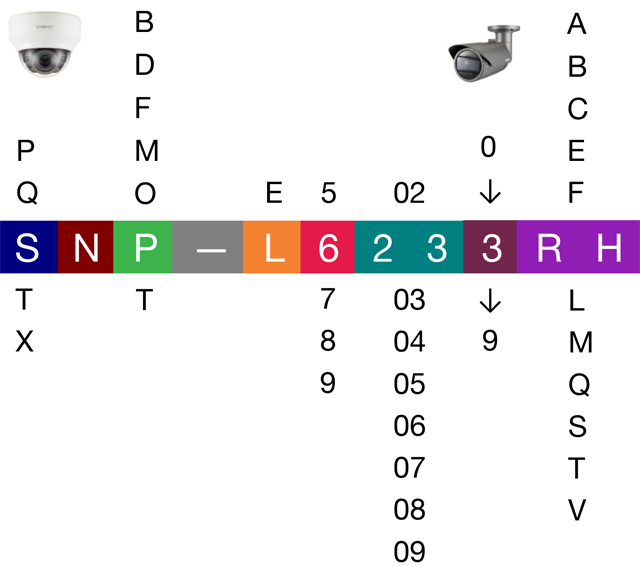The Wisenet range (previously known as Samsung Wisenet and now known as Hanwha Vision Wisenet) has a wide variety of cost-effective products which share a similar naming convention. They typically start with three letters, a dash, then four numbers and sometimes a letter or two afterwards.
Wisenet products are an increasingly popular choice for customers of all budgets. So, now it felt like the right time to delve into what lies behind their product naming convention and how you can use it to very quickly understand the capabilities of a product in the Wisenet range.
First thing to note is that there are different meanings for IP camera product numbers and other products. First the cameras…
Wisenet camera naming convention
The range includes a variety of IP camera types offering a range of functionalities. To make things relatively simple, their naming covers both static and pan tilt zoom cameras.
Here’s a summary of the possible combinations:

More about the series
The Q series contains the Wisenet starter cameras for general surveillance. The X series includes X-Plus models which contain the latest Wisenet chip to improve processing performance on camera. The older X models also contain an array of features making them an adaptable solution. Finally, the P, or premium, series captures 4k video and contains multi-sensor and panoramic cameras.
There are also specialist series, for example, the T series contains positioning, thermal and explosion-proof cameras for demanding applications.
If you notice an ‘S’ in the product name, this means it’s a legacy product. There are a few of these still available at the time of writing.
Let’s break down a product name, to see what each element means:
| Model # | What this means |
|---|---|
| X | Series name |
| N | N = network |
| O |
Shape
B = Box D = Dome F = Fisheye M = Multi-sensor O = Bullet P = Pan tilt zoom U = Positioning V = Vandal Z = Zoom box |
| - | If there is a letter here it represents the grade |
| 8 |
Resolution
5 = 1 megapixel (MP) 6 = 2MP 7 = 3-4MP 8 = 5-7MP 9 = 8 or more megapixel |
| 08 |
Lens
01 = fixed 3mm or less 02 = fixed 3.1 - 4mm 03 = fixed 4.1 - 6mm 04 = fixed 6.1 - 9.9mm 05 = fixed 10mm or more 06 = 2x varifocal 07 = 2x-9x varifocal 08 = 2x-9x motorised varifocal 09 = 10x or more varifocal Any other numbers refer to the zoom level of a PTZ |
| 0 |
Version
5 = Half-inch extraLux chip |
| R |
Features (structured by priority)
B = Black colour casing C = Corner mounting D = Dual lens E = Explosion proof F = Flush or SFP LC H = External housing L = Laser M = Mobile (M-12 connector) Q = Quad eye R = Infrared S = Stainless steel TR = Thermal radiometric V = Vandal W = White colour casing Z = Pan tilt remote zoom |
This makes the XNO-8080R a 5MP motorised varifocal bullet camera with IR. The Wisenet XNP-6320H, for example, is an outdoor 2MP pan tilt zoom camera with 32 times optical zoom.
What you’ll notice, now you can see the logic behind the naming convention, is that Wisenet offers parallel cameras in different form factors. For example, XNV-8080R and XNO-8080R are very similar products under the hood. The main difference is their exterior, bullet or dome in this case.
Recorder naming convention
With the smaller selection of units, the Wisenet NVR range naming convention is simpler. The diagram below shows the possible combinations for network video recorders.

The model names have a similar meaning to the cameras. NVRs starting with a P are the top of the range and feature raid 5/6, while the Q models are starter units. The Q range NVRs also have a limitation in terms of size, as they typically have less than 16 channels.
This is how the NVR model number breaks down.
| Model # | What this means |
|---|---|
|
P = Premium
X = Versatile Q = Quality |
|
| R | R = Recorder |
| N | N = NVR |
|
Grade
Empty = basic |
|
| -16 |
Number of channels or mbps
4 = 4 channels 8 = 8 channels 16 = 16 channels 10 = 100-199mbps 20 = 200-299mbps 30 = 300-399mbps 40 = 400-499mbps 50 = 500-599mbps |
| 1 | Major version 0-9 |
| 0 | Version 0-9 |
| S |
Function
A = version 2 S = PoE switch M = PoE switch with M12 connector |
The example above, a Wisenet XRN-1610S, is a 16-channel network video recorder with a PoE switch. While the XRN-410S is a 4-channel NVR.
Conclusion
Armed with the information above, you can now work out what features lie behind the Wisenet product names. This gives you the key features of their products at a glance.
Of course, if you’re shopping with us, we already include the main features of a product to help you.
Take a look at the Wisenet camera range or their NVRs, typically available for next-day delivery.



